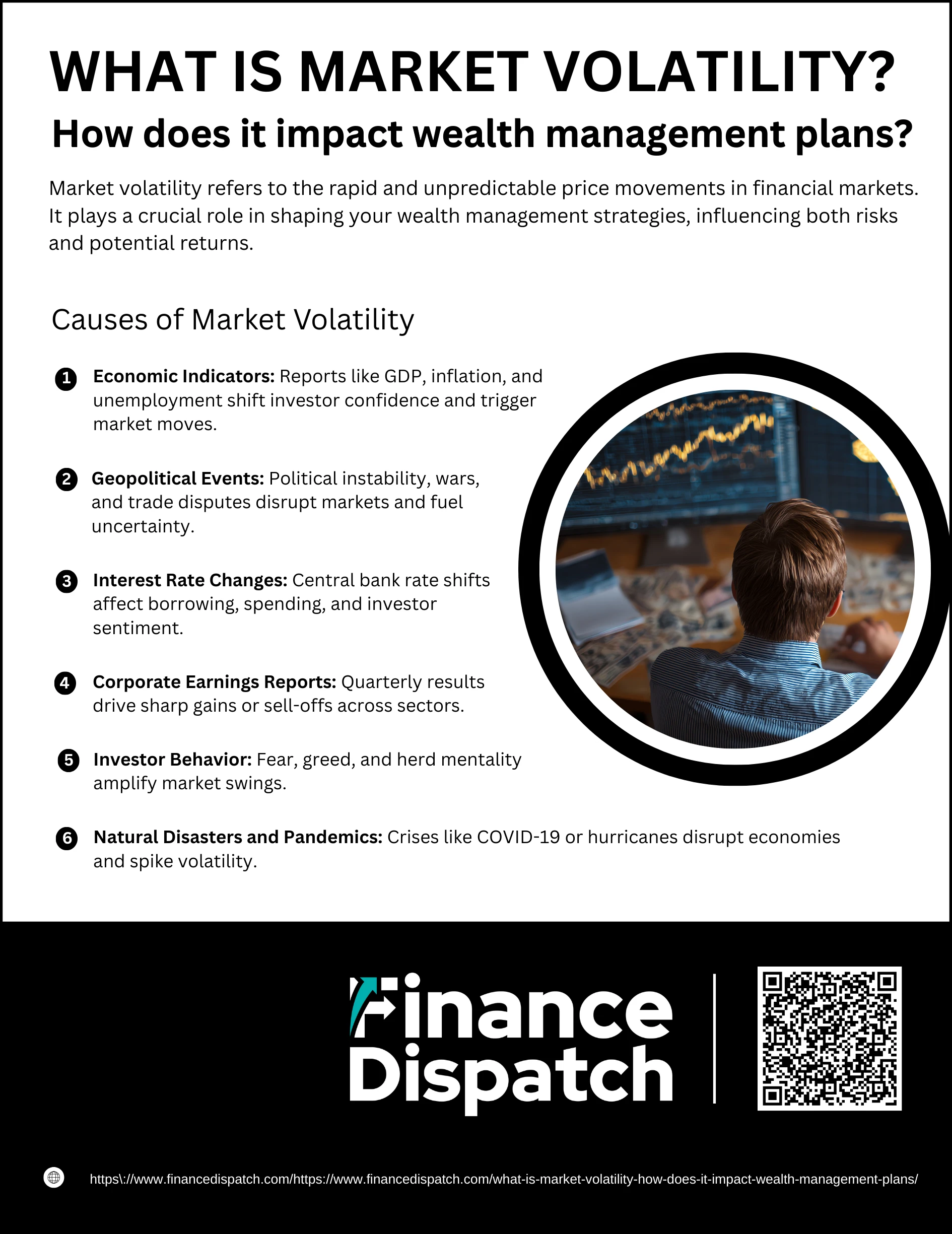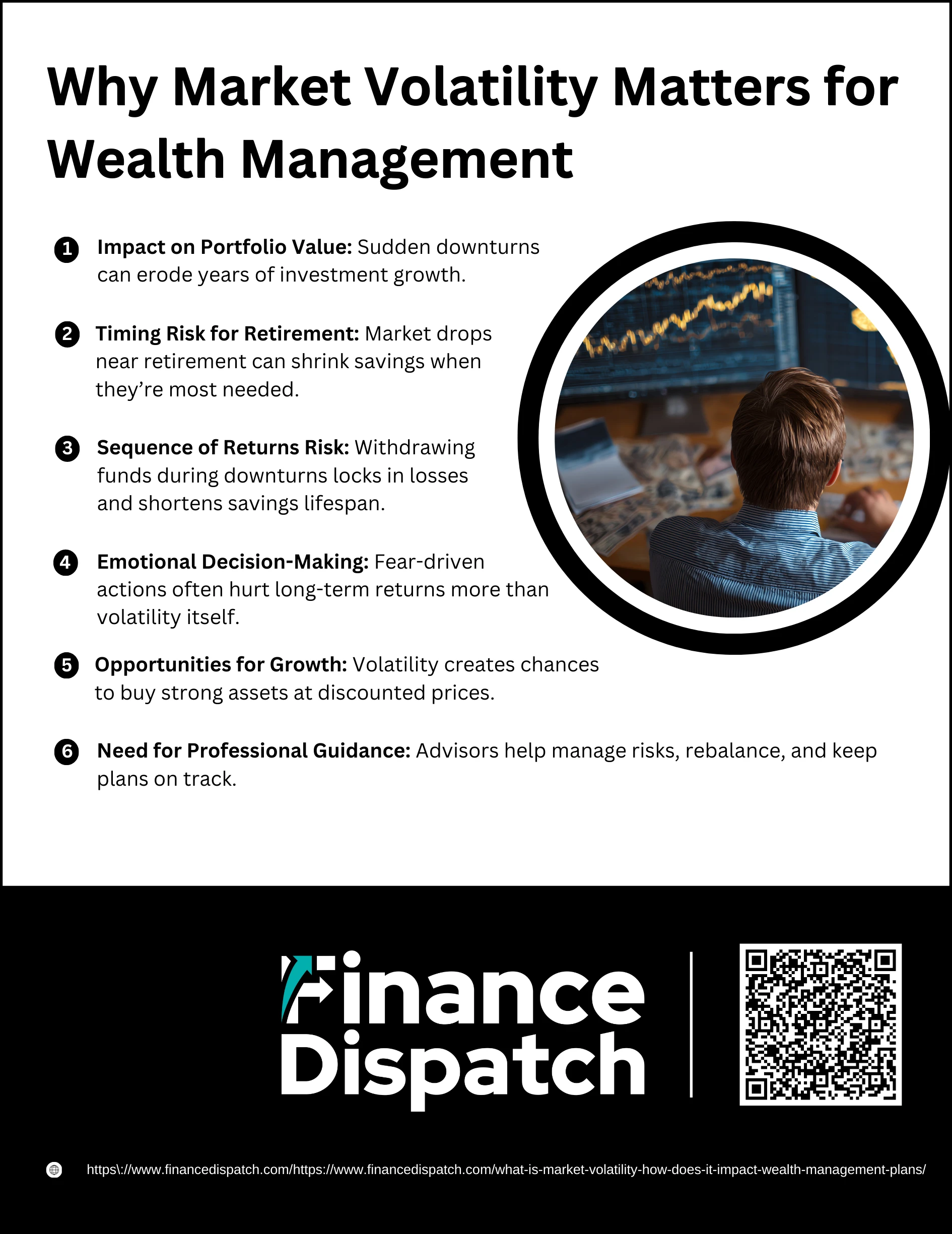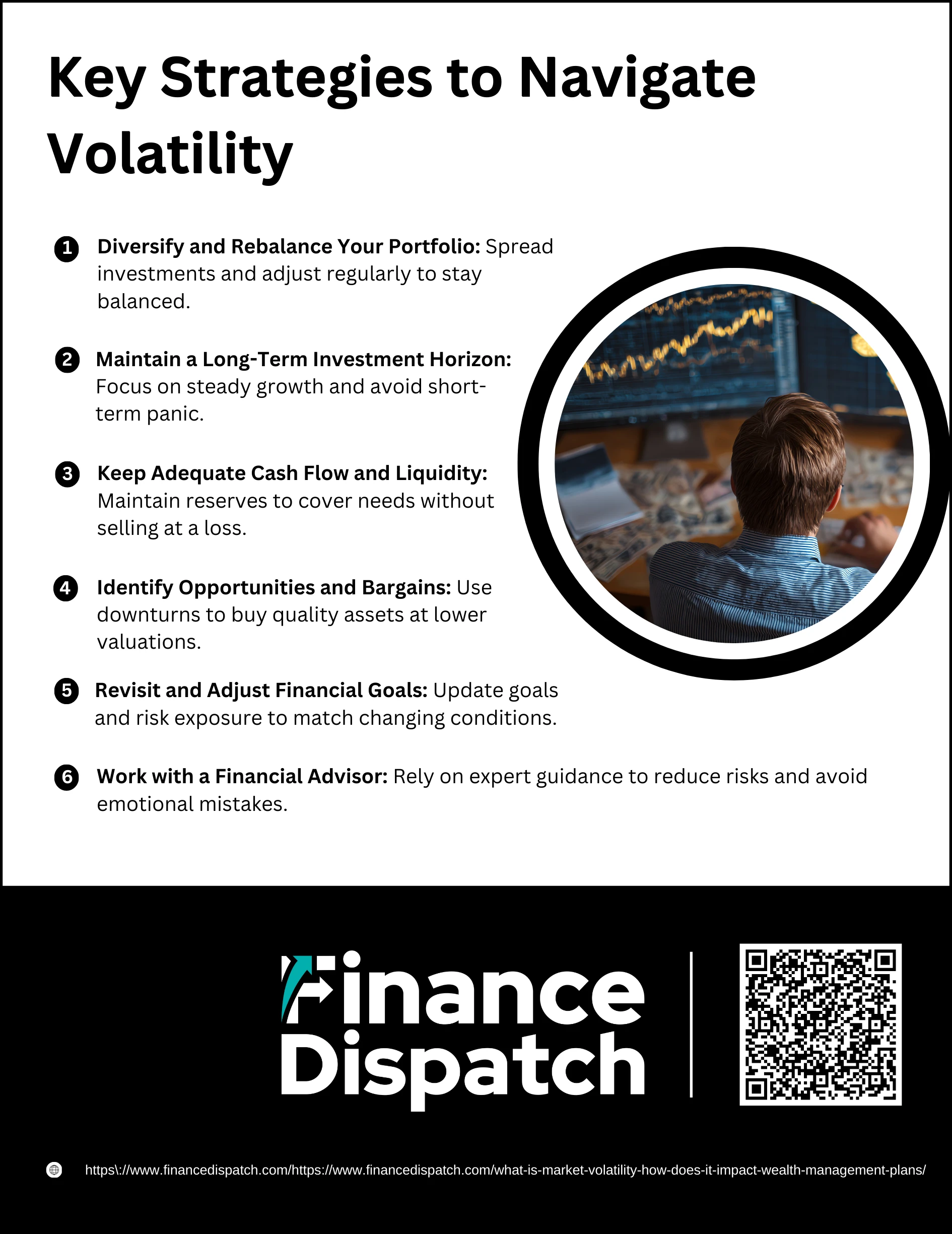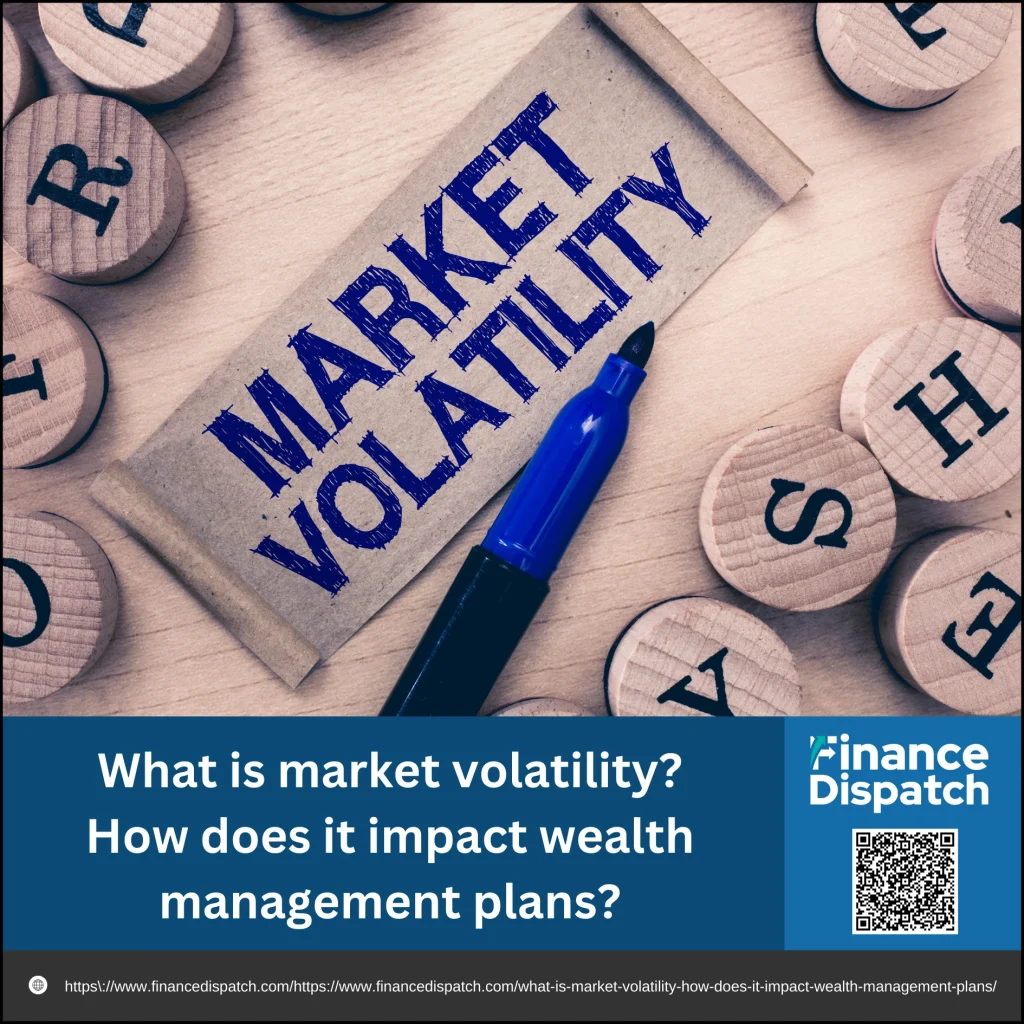In the world of investing, one of the most common terms you’ll hear is market volatility. It describes the unpredictable ups and downs in asset prices that can leave investors feeling uncertain about their financial future. From global events and shifting economic policies to sudden market shocks, volatility is an inevitable part of financial markets. While these fluctuations may seem unsettling, their impact on wealth management plans is profound. Understanding what volatility means and how it affects your portfolio is essential—not only to protect your savings but also to uncover opportunities that uncertainty often brings. By learning how to manage volatility effectively, you can maintain stability, stay aligned with your long-term goals, and make confident financial decisions even in turbulent times.
What is Market Volatility?
Market volatility refers to how much and how quickly the prices of financial assets, such as stocks or bonds, move up and down over time. When prices change gradually and remain stable, volatility is considered low, but when they fluctuate sharply within short periods, volatility is high. For example, while major stock indices like the S&P 500 usually shift less than 1% in a day, periods of uncertainty can trigger swings of 5% or even 10%. Volatility is often seen as unsettling because it creates uncertainty, yet it is a normal part of investing. In fact, it reflects the natural response of markets to economic news, policy changes, or investor sentiment, making it an important measure of both risk and opportunity.
 Causes of Market Volatility
Causes of Market Volatility
Market volatility arises from a variety of interconnected factors that influence investor confidence and market behavior. By recognizing these triggers, you can better understand why markets fluctuate and how to prepare your wealth management plan for uncertainty.
1. Economic Indicators
Key reports such as GDP growth, unemployment rates, and inflation provide signals about the health of the economy. When data comes in weaker than expected, it can spark fears of slowdown, leading investors to sell off assets. On the other hand, stronger-than-expected data can push markets higher, sometimes creating over-optimism.
2. Geopolitical Events
Political instability, wars, trade disputes, or elections often bring uncertainty to global markets. For example, tensions between countries can disrupt trade flows, impact supply chains, and cause sudden reactions in stock and commodity prices. Investors typically adjust their portfolios quickly during such times, leading to sharp price movements.
3. Interest Rate Changes
Central banks, like the Federal Reserve, use interest rates to control inflation and stimulate growth. Rising rates increase borrowing costs for businesses and consumers, which can reduce spending and corporate profits. Falling rates, by contrast, can stimulate growth but may also raise inflation concerns—both scenarios contributing to volatility.
4. Corporate Earnings Reports
Public companies release quarterly earnings, and markets react to whether results beat or miss expectations. A strong report can drive stock prices sharply upward, while disappointing earnings or reduced future guidance can trigger sell-offs. Since major companies influence entire sectors, these movements can ripple across the broader market.
5. Investor Behavior
Market psychology plays a powerful role. Fear, greed, and herd mentality often drive investors to act impulsively—buying after markets rise or panic-selling during downturns. These emotional reactions can exaggerate market swings, causing volatility to spike even when fundamentals remain steady.
6. Natural Disasters and Pandemics
Events such as earthquakes, hurricanes, or global health crises like COVID-19 disrupt economies by halting production, reducing demand, and unsettling supply chains. These shocks can create extreme volatility as markets struggle to assess the long-term impact on businesses and economies.
 Why Market Volatility Matters for Wealth Management
Why Market Volatility Matters for Wealth Management
Market volatility is more than just unpredictable swings in stock prices—it can reshape how wealth is built, preserved, and distributed over time. For investors and families working toward financial security, understanding why volatility matters is essential to protecting goals and avoiding costly mistakes.
1. Impact on Portfolio Value
When markets swing sharply, the immediate effect is seen in portfolio balances. A heavily equity-focused portfolio may lose significant value during a downturn, eroding years of growth in a short span. This fluctuation can feel discouraging, particularly for investors without a diversified strategy, and highlights the importance of spreading investments across asset classes.
2. Timing Risk for Retirement
For investors approaching retirement, volatility poses the danger of shrinking savings just when funds are needed most. If the market drops right before or soon after retirement begins, there may not be enough time for portfolios to recover, potentially forcing retirees to adjust their lifestyle or postpone retirement.
3. Sequence of Returns Risk
Volatility is especially harmful when withdrawals are made during market downturns. Taking money out when investments are down locks in losses and shortens how long savings can last. Having cash reserves or stable investments can protect against this risk, giving retirees time to let the market rebound before drawing more income.
4. Emotional Decision-Making
Market swings often trigger fear and anxiety, leading investors to sell at the bottom or chase rallies at the top. These emotional choices can hurt long-term returns more than the volatility itself. Staying disciplined and following a wealth management plan can help keep decisions rooted in strategy instead of emotions.
5. Opportunities for Growth
Volatility isn’t always negative. It can create opportunities to purchase strong assets at discounted prices. Investors who stay patient and keep cash or liquidity available may benefit from market corrections by buying quality stocks, bonds, or funds when valuations are more attractive.
6. Need for Professional Guidance
Wealth management during volatile times often requires expertise beyond do-it-yourself investing. Advisors can stress-test financial plans, rebalance portfolios, and suggest strategies such as diversification, tax-loss harvesting, or defensive allocations. Having professional guidance provides reassurance and helps ensure decisions align with long-term goals, not short-term fears.
 Key Strategies to Navigate Volatility
Key Strategies to Navigate Volatility
Market volatility is an unavoidable part of investing, but it doesn’t have to derail your wealth management goals. With the right strategies, you can reduce risks, avoid emotional decisions, and even take advantage of opportunities created by uncertain times.
1. Diversify and Rebalance Your Portfolio
Diversification is one of the most powerful tools against volatility. By spreading your investments across asset classes like stocks, bonds, real estate, and cash, you minimize the risk of one sector dragging down your entire portfolio. Rebalancing ensures your portfolio stays aligned with your risk tolerance and long-term objectives. For instance, if stocks outperform and take up a larger portion of your portfolio, rebalancing allows you to shift some gains into more stable assets to maintain balance.
2. Maintain a Long-Term Investment Horizon
Volatile markets often tempt investors to make short-term decisions, such as selling during downturns or chasing hot trends. However, history shows that markets tend to recover over time. Maintaining a long-term perspective helps you ride out short-term swings while keeping your focus on building wealth steadily. Investors who stay committed to their goals are more likely to benefit from market rebounds than those who attempt to time every move.
3. Keep Adequate Cash Flow and Liquidity
Having cash reserves or liquid investments is critical during volatile times. A healthy emergency fund allows you to cover short-term expenses without being forced to sell assets at a loss. Liquidity also provides flexibility to act when opportunities arise, whether that means investing in undervalued assets or handling unexpected personal financial needs without disrupting your long-term plan.
4. Identify Opportunities and Bargains
While volatility can feel like a threat, it often creates attractive entry points. Market corrections may temporarily lower the value of strong companies or sectors, giving disciplined investors a chance to buy at discounted prices. For example, during downturns, high-quality stocks or bonds can be purchased at better valuations, positioning your portfolio for greater growth when markets stabilize.
5. Revisit and Adjust Financial Goals
Personal circumstances and market conditions change over time, and so should your wealth management plan. Periodically reviewing your goals ensures they remain realistic and achievable in the face of volatility. For instance, adjusting your retirement contributions, rethinking risk exposure, or shifting investment priorities can help keep you on track regardless of short-term turbulence.
6. Work with a Financial Advisor
Navigating volatility alone can be overwhelming. A financial advisor offers expertise, perspective, and discipline during uncertain times. They can stress-test your financial plan, recommend defensive allocations, and apply strategies such as tax-loss harvesting or hedging to manage risks. Just as importantly, they provide reassurance, helping you avoid impulsive decisions that could harm your long-term financial security.
Impact on Retirement and Savings
Market volatility can be especially challenging for retirement planning and long-term savings. Sharp downturns may reduce the value of your portfolio at critical moments, while premature withdrawals during declines can lock in losses. Understanding the main risks and how to manage them is essential for protecting your financial future.
| Risk Factor | How It Affects Retirement Savings | Management Approach |
| Timing Risk | A market downturn close to retirement can shrink savings before withdrawals begin. | Adjust retirement date, shift to more stable assets. |
| Sequence of Returns Risk | Withdrawing funds during a downturn can lock in losses and shorten portfolio life. | Maintain cash reserves, use conservative withdrawal rules. |
| Asset Class Impact | Equities face high volatility, while bonds and cash are more stable but may offer lower growth. | Balance portfolio with stocks, bonds, and defensive assets. |
| Emotional Decision-Making | Panic selling can permanently reduce retirement funds. | Stick to long-term plan, seek professional guidance. |
| Longevity Risk | Living longer than expected increases the impact of volatility on savings. | Diversify income sources, consider annuities. |
Managing Emotions and Behavior of market volatility
Market volatility often tests investors’ emotions more than their portfolios. Fear of losses can drive panic selling, while sudden gains may encourage overconfidence and risky decisions. These emotional reactions frequently harm long-term outcomes, as they lead to buying high and selling low—the opposite of successful investing. Managing behavior during turbulent times means focusing on discipline, patience, and a well-structured financial plan. By resisting short-term impulses and staying committed to long-term goals, investors can avoid costly mistakes and maintain stability. Seeking reassurance from a financial advisor can also help reduce anxiety and keep decisions grounded in strategy rather than emotion.
Role of Financial Planning and Advisors
Financial planning and professional advice play a crucial role in navigating market volatility. A well-structured plan acts as a roadmap, keeping investors focused on long-term goals rather than reacting to short-term swings. Advisors add another layer of support by providing objective guidance, stress-testing portfolios, and recommending strategies such as diversification, rebalancing, and tax-loss harvesting. Just as importantly, they serve as a steady voice during turbulent times, helping clients manage emotions and avoid impulsive decisions that could harm wealth. By combining disciplined planning with expert insight, investors can approach volatility with confidence and turn uncertainty into an opportunity for stability and growth.
Conclusion
Market volatility is an unavoidable part of investing, but it doesn’t have to derail your financial future. By understanding its causes and effects, you can prepare for uncertainty rather than fear it. Wealth management strategies such as diversification, maintaining liquidity, and keeping a long-term perspective help protect your assets during turbulent times. Just as importantly, disciplined behavior and professional guidance ensure you avoid emotional pitfalls and stay focused on your goals. When approached strategically, volatility is not just a challenge—it can also be an opportunity to strengthen your financial plan and build lasting wealth.



